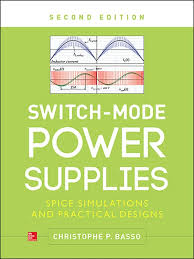White Paper: Mastering Switching Mode Power Supply Design with SPICE Simulation
Abstract
Switching Mode Power Supplies (SMPS) are ubiquitous in modern electronic devices, providing efficient and reliable power conversion. SPICE simulation is a powerful tool for designing and analyzing SMPS circuits, enabling engineers to optimize performance, reduce development time, and improve product reliability. This white paper explores the fundamentals of SMPS design, the role of SPICE simulation, and practical applications using the insights from Basso's "Switching Mode Power Supplies" 2nd edition.
Introduction
SMPS have revolutionized power electronics by offering high efficiency, compact size, and precise voltage regulation. However, designing SMPS can be complex due to the intricate interplay of various components and circuit topologies. SPICE simulation provides a virtual environment to test and analyze circuit behavior before physical prototyping, allowing for iterative design optimization and risk mitigation.
Key Concepts in SMPS Design
- Basic Principles of Power Electronics:
- Power Semiconductor Devices: Understanding the characteristics of MOSFETs, IGBTs, and diodes.
- Basic Power Converter Topologies: Buck, boost, buck-boost, and flyback converters.
- Power Stage Design: Designing the power stage, including component selection and thermal considerations.
- Control Techniques:
- Pulse-Width Modulation (PWM): Generating PWM signals to control the switching of power devices.
- Feedback Control Loops: Implementing feedback loops to regulate output voltage and current.
- Loop Compensation Techniques: Designing compensation networks to stabilize the control loop.
- Magnetic Components:
- Transformer Design: Designing transformers for efficient power transfer.
- Inductor Design: Selecting and designing inductors for energy storage and filtering.
- EMI and EMC Considerations:
- Filter Design: Designing input and output filters to mitigate electromagnetic interference (EMI).
- Layout Techniques: Implementing proper layout techniques to reduce EMI and improve circuit performance.
The Role of SPICE Simulation
SPICE simulation offers several advantages in SMPS design:
- Circuit Analysis: Simulating circuit behavior under various conditions to identify potential issues and optimize performance.
- Component Stress Analysis: Analyzing component stress, such as voltage and current ratings, to ensure reliable operation.
- Transient Analysis: Simulating transient responses to load changes and input voltage variations.
- Small-Signal Analysis: Analyzing the small-signal behavior of the control loop to determine stability and performance.
Practical Applications Using Basso's Book
- Designing a Buck Converter: Simulate the power stage, control loop, and output filter to optimize efficiency and transient response.
- Analyzing a Flyback Converter: Evaluate the impact of component tolerances and parasitic effects on converter performance.
- Designing a Multiphase Buck Converter: Simulate the interleaving of multiple phases to improve current sharing and reduce ripple current.
- Investigating EMI and EMC Issues: Simulate the radiated and conducted emissions of an SMPS to identify potential sources of interference.
Conclusion
By mastering the fundamentals of SMPS design and effectively utilizing SPICE simulation, engineers can create efficient, reliable, and cost-effective power supplies. Basso's "Switching Mode Power Supplies" provides a solid foundation for understanding the theory and practice of SMPS design. By combining this knowledge with SPICE simulation, engineers can accelerate the design process and develop innovative power solutions.
References
- Basso, C. K. (2015). Switching Power Supplies: A Tutorial Guide. McGraw-Hill Education.
- OrCAD PSpice: A powerful SPICE simulator for circuit analysis and simulation.
- LTspice: A free, high-performance SPICE simulator.
- Texas Instruments: Offers a wide range of power management ICs and design tools.
- Analog Devices: Provides comprehensive resources for power electronics design, including simulation tools and application notes.
By leveraging these resources and applying the principles outlined in this white paper, engineers can excel in the field of SMPS design and contribute to the advancement of power electronics technology.



